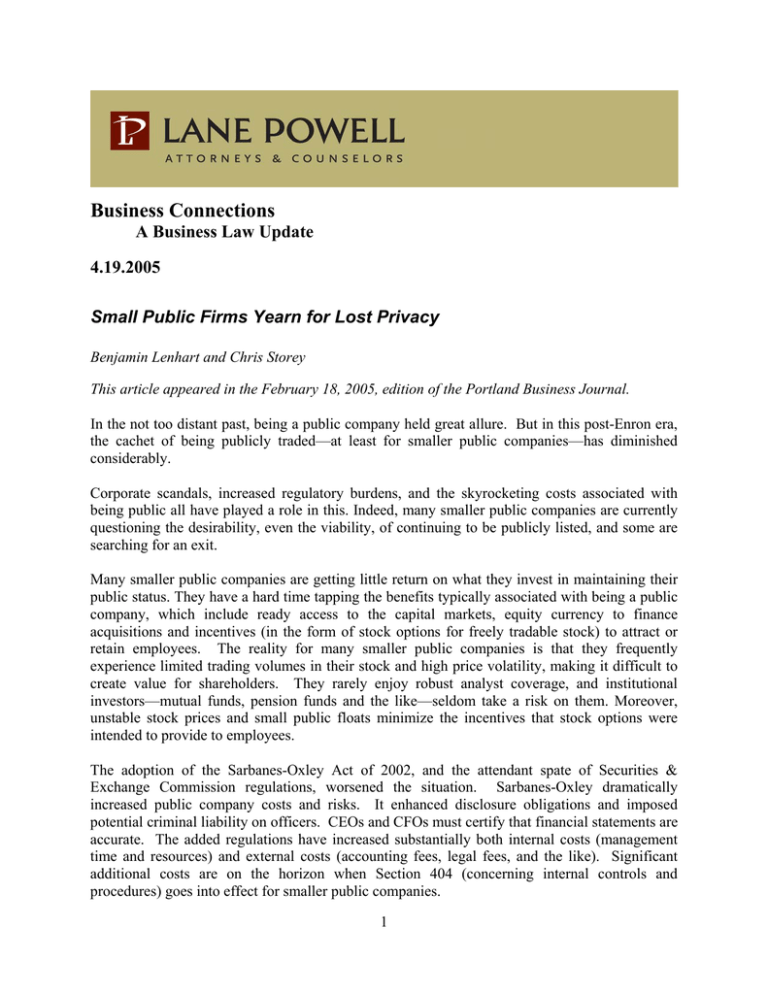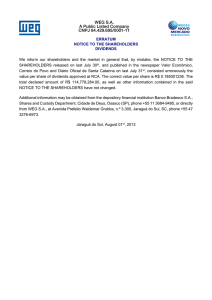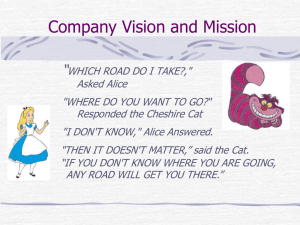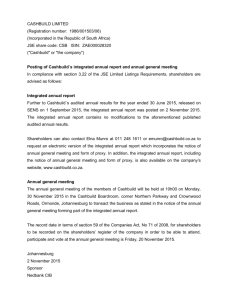Business Connections A Business Law Update 4.19.2005
advertisement

Business Connections A Business Law Update 4.19.2005 Small Public Firms Yearn for Lost Privacy Benjamin Lenhart and Chris Storey This article appeared in the February 18, 2005, edition of the Portland Business Journal. In the not too distant past, being a public company held great allure. But in this post-Enron era, the cachet of being publicly traded—at least for smaller public companies—has diminished considerably. Corporate scandals, increased regulatory burdens, and the skyrocketing costs associated with being public all have played a role in this. Indeed, many smaller public companies are currently questioning the desirability, even the viability, of continuing to be publicly listed, and some are searching for an exit. Many smaller public companies are getting little return on what they invest in maintaining their public status. They have a hard time tapping the benefits typically associated with being a public company, which include ready access to the capital markets, equity currency to finance acquisitions and incentives (in the form of stock options for freely tradable stock) to attract or retain employees. The reality for many smaller public companies is that they frequently experience limited trading volumes in their stock and high price volatility, making it difficult to create value for shareholders. They rarely enjoy robust analyst coverage, and institutional investors—mutual funds, pension funds and the like—seldom take a risk on them. Moreover, unstable stock prices and small public floats minimize the incentives that stock options were intended to provide to employees. The adoption of the Sarbanes-Oxley Act of 2002, and the attendant spate of Securities & Exchange Commission regulations, worsened the situation. Sarbanes-Oxley dramatically increased public company costs and risks. It enhanced disclosure obligations and imposed potential criminal liability on officers. CEOs and CFOs must certify that financial statements are accurate. The added regulations have increased substantially both internal costs (management time and resources) and external costs (accounting fees, legal fees, and the like). Significant additional costs are on the horizon when Section 404 (concerning internal controls and procedures) goes into effect for smaller public companies. 1 In short, smaller public companies are paying for an honor that confers few privileges. Mark Twain’s famous rejoinder has some resonance here. When threatened with being tarred, feathered and ridden out of town on a rail, he noted that “if it weren’t for the honor and glory of the thing, I’d just as soon walk.” These companies have persevered, hoping for better fortunes and realization of the promised benefits. These companies stand at a crossroads. They must either spend the additional money each year to stay public (and erode profit margins in the absence of growth to offset the increased costs) or find a way to gracefully exit the public markets. As a result, many are pondering variations of these alternatives: maintaining the status quo, going dark or going private. Status Quo. Smaller public companies can bear the increased costs, hoping that at some point in the future the benefits will outweigh the costs. There may be a glimmer of hope on the horizon that gives that option some credence. The SEC recently announced the creation of a roundtable to consider Sarbanes-Oxley’s impact on smaller public companies. It is possible that SEC rules could be modified to alleviate some of the financial burden on these companies, but such a reprieve is hardly a sure thing. Going Dark. A public company can remove itself from the public markets by “going dark,” a process in which it voluntarily delists its stock from the exchange or quotation system and deregisters from its reporting obligations under the Securities Exchange Act of 1934. The alternative is available only to companies that either have fewer than 300 shareholders of record, or have less than $10 million in assets and fewer than 500 shareholders of record. Going dark allows the company to avoid the heightened compliance costs and the process is relatively inexpensive. Going dark, however, is not without its risks. Not the least of these is the potential of disgruntled shareholders upset over the lack of a market in the shares. That, of course, could lead to shareholder litigation over the decision to delist. The company also may have certain reporting obligations to shareholders under various state corporate laws. And operating a private company with a significant number of shareholders can be difficult. Going Private. Another option is to go private by restructuring the equity ownership via one of several methods. Going private transactions have increased: in 1993, only 17 companies went private nationally; in 2003, the number jumped to 142, according to Thomson Financial. That was slightly down from the peak of 162 in 2002. Taking a company private can maximize shareholder value by reducing compliance and administrative costs associated with being a public company. When a public company goes private one or more controlling shareholders and/or management (with or without investors) buy the public shares. The company is then no longer subject to the stringent and costly reporting requirements imposed on it when it was public. The transaction can be structured a number of ways ranging from a merger to a two-step tender offer to a reverse stock split. Each structure involves different costs, risks, disclosure, and timing considerations. 2 Going private transactions do present special problems and issues, primarily because interested parties (such as a controlling shareholder and/or management) are buying out other shareholders. For that reason, conflict of interest issues, heightened standards of judicial review, increased litigation risks and enhanced disclosure requirements are involved, all of which must be carefully assessed when considering the route of going private. Approximately 28 of Oregon’s public companies have a market capitalization of $100 million or less; another 10 public companies have a market capitalization of less than $200 million. These companies face difficult decisions in the months ahead. Their response to the challenges of increasing costs and reduced benefits will significantly impact their shareholders’ fortunes. Regardless of whether they choose the status quo, going dark or going private, they would be wise to fully inform themselves of the costs, benefits and risks of each alternative and, in the process, consult with experienced investment bankers, lawyers and accountants. Benjamin Lenhart, a partner with Lane Powell PC, practices in the areas of corporate finance and securities, and mergers and acquisitions. He can be reached at lenhartb@lanepowell.com or 503-778-2052. Chris Storey, an attorney with Lane Powell PC, focuses his practice on corporate and transactional matters, including mergers and acquisitions. He can be reached at storeyc@lanepowell.com or 503-778-2139. For more information on these or other business issues, please contact our Business Lawyers at Lane Powell PC: (206) 223-7000 Seattle (503) 778-2100 Portland businesslaw@lanepowell.com www.lanepowell.com We provide Connections as a service to our clients, colleagues and friends. It is intended to be a source of general information, not an opinion or legal advice on any specific situation, and does not create an attorney-client relationship with our readers. If you would like more information regarding whether we may assist you in any particular matter, please contact one of our lawyers, using care not to provide us any confidential information until we have notified you in writing that there are no conflicts of interest and that we have agreed to represent you on the specific matter that is the subject of your inquiry. © 2005 Lane Powell PC Seattle - Portland - Anchorage - Olympia - London 3








